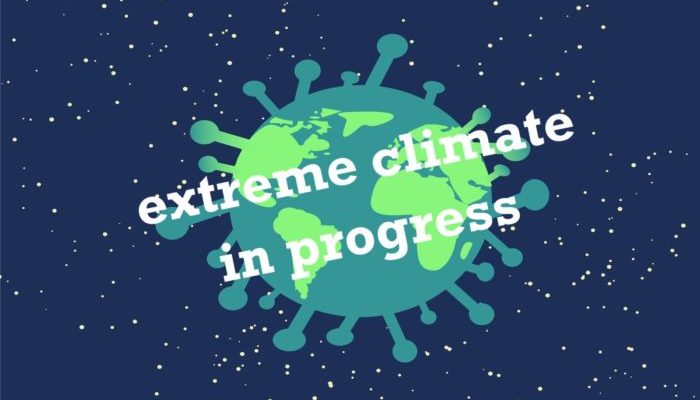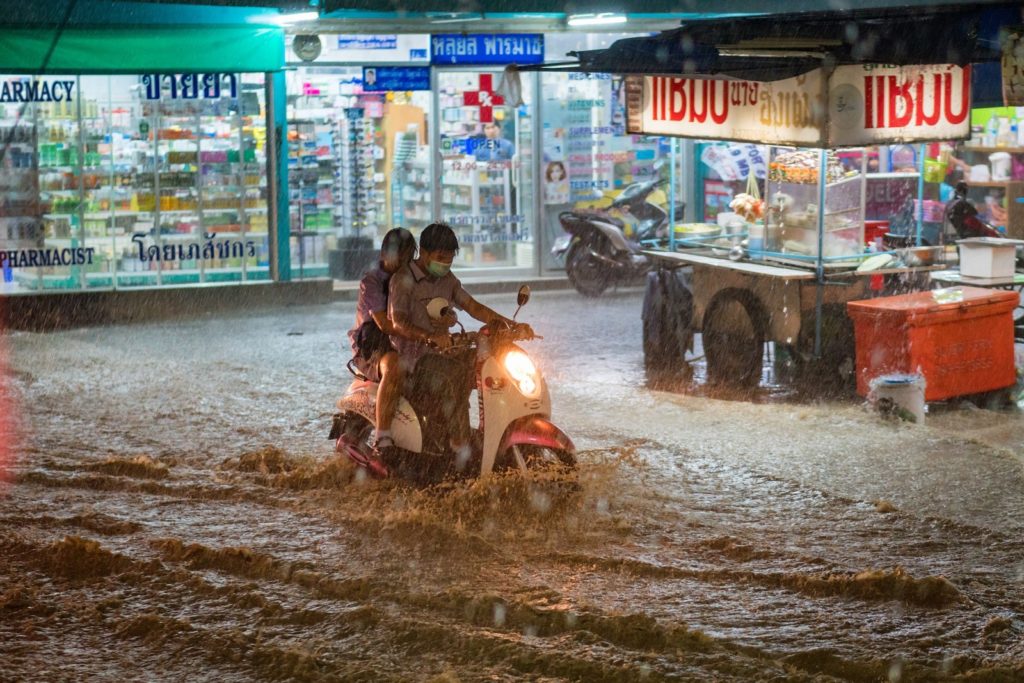
Even though significant epidemics and pandemics have been recorded many times throughout human history, the Covid-19 pandemic demonstrated how vulnerable our societies still are. While the consequences of the pandemic are still ongoing, the global response so far can potentially offer some insights to support climate change response.
Undoubtedly, the world is already experiencing a wide range of changes in the climate, from slow onset events, like sea-level rise, desertification and loss of biodiversity to climate extremes like deadly heatwaves, damaging droughts, wildfires, and hurricanes. Climate change continues to pose a risk for our societies [1], although the effects on individual regions depend on the level of vulnerability and existing capacity to adapt.
In the European Union (EU), the losses associated with the occurrence of more frequent climate-related extremes are estimated at over EUR 12 billion per year, and this could reach EUR 170 billion if the global mean surface temperature increases by 3°C above pre-industrial levels [2]. Recently, the European Commission highlighted that insufficient preparation for climate change may have significant consequences and adopted a new EU Strategy on Adaptation to Climate Change that sets out the path to prepare for the impacts that cannot be avoided.
But are we doing enough to prepare for the future? And, can we use the experience gained from the pandemic response to pave the way for climate resilience?
Action on hold?
A year or so ago, no one could have even imagined that our lives would change so drastically overnight. These emotions must be similar to those experiencing millions of people affected by or displaced due to climate extremes in different parts of the world. Our lives have been on hold since the start of the pandemic. Have we also put on hold our efforts to increase our ability to adapt and recover from climate hazards without compromising sustainable development over the longer term?
Recently, in the United Kingdom (UK), the Adaptation Committee emphasised that the severity of the risks linked to climate change should not be underrated as they will not fade away even if we achieve the net-zero targets. Although the criticality of climate change adaptation is acknowledged, action to increase resilience is failing to keep pace with the increasing climate risks. For example, even though the UK already experiences an increase in temperature compared to pre-industrial levels and frequent extreme heat events, in the past five years, over 570,000 new homes have been built that are not resilient to this change [3].

Extreme rainfall can lead to frequent damaging flooding in several parts of the world (Photo source: Pixabay)
Although there seems to be an adaptation gap in the UK, there is capacity and resources to respond successfully to climate risks. What happens in the case of the most vulnerable countries? While many of these countries, especially those in tropical and subtropical regions, are among the least responsible for greenhouse gas emissions, they are exposed to climate risk and already experiencing climate change impacts. For example, the Small Island Developing States (SIDS) are among the most vulnerable to global climate change due to their climate and socio-economic characteristics. SIDS are already experiencing the impacts of sea-level rise and changes in temperature patterns and rapid-onset of temporary events like storms and flooding [4].
Considering that climate change is expected to amplify existing risks or create new types of threats, the longer it takes to address them, the higher the costs. In the case of the Caribbean region alone, the cost of inaction has been estimated to be over US$22 billion annually by 2050, which is equivalent to 10% of the current size of the Caribbean economy [4].
The best way to start adjusting to a changed future is to change…
Sometimes the quickest way forward is not a straight line; sometimes, you need to take the indirect route. Scientists emphasise the importance of advancing our understanding, assessing climate risk and vulnerabilities, raising awareness, building capacity, preparing, prioritising action in response, and collaborating. Sounds familiar? Didn’t we have a similar reaction to the recent pandemic?
Like the pandemic, the impacts of climate change are expected to be extremely severe in the most vulnerable parts of the world, presenting limited adaptive capacity; vulnerable societies seem to be the least capable of responding and adapting. Even in Europe, losses attributed to climate change are distributed disproportionately, with the weakest economies facing the most significant challenge. The latter raises equity, justice, and fairness issues, according to the Intergovernmental Panel on Climate Change (IPCC), and we need to limit the effects of climate change if we wish to achieve sustainable development [1]. Furthermore, like the coronavirus, climate change is a global issue that also ignores borders. Thus, a coordinated approach may guarantee early preparation, better response to events and quicker recovery in a climate hazard occurrence.
Options to increase climate resilience exist. They range from defence measures to fight, for example, flooding, to redesign infrastructure and networks to incorporate new standards to early warning systems, for example for hurricanes or heatwaves, and changing processes, procedures or even regulations to ensure a higher level of readiness than the current one. Depending on the option, the potential for reducing vulnerability and risk varies, and although many counties are undertaking action to build climate-resilient economies, more needs to be done.
Let’s look at the Covid-19 response and policies that have been introduced to control the spread of the virus; the effectiveness of the wide-ranging measures that have been implemented depends on the scientific and technological progress, which is supported by financial mechanisms, international cooperation and behaviour change [5]. Similarly, the successful implementation of climate resilience policies relies on research for innovative solutions, adopting new technologies, investments, and adaptive culture. Also, international cooperation and coordination across different sectors at national and international levels is essential; having a response mechanism to allow for synergies at different levels can support increasing resilience.
Although there are frameworks to enable international cooperation, such as the United Nations Framework Convention on Climate Change (UNFCCC), the focus has been mainly on climate change mitigation. Climate adaptation actions have received less attention, although this seems to be changing. Furthermore, financial support to support climate resilience in the most vulnerable countries is not as much as climate change mitigation support according to the Organisation for Economic Cooperation and Development (OECD); only 21% of the overall climate finance in 2018 went to climate adaptation activities [6].
Like health resilience, improving climate resilience includes assessing current vulnerability and risks and how these will change over time and undertake action to better cope with these risks. In most cases, the key features of the urban and infrastructure systems are designed based on the assumption that the climatic conditions will, to a certain extent, resemble the current ones, meaning that, in several instances, they are designed to fail. Therefore, integrating climate change risk into the design, planning, operation, and decision-making can reduce vulnerability over time.
Shouldn’t we advance our understanding, prioritise action and find the means to strengthen the most vulnerable parts of urban systems? No doubt learning from the past hazard occurrences will allow the mitigation of risk of the future ones. Nevertheless, more work is needed to fully understand the impacts and implications of climate change in the most vulnerable countries, considering the individual socio-economic elements and the links between risk reduction, adaptation and sustainable development.
With the two-fold threat of Covid-19 and climate change over our heads, supporting risk reduction and building resilience is essential. One thing for sure is that there is no “one size fits all” solution.
References
[1] Intergovernmental Panel on Climate Change (IPCC) (2018). AR5 Climate Change 2014: Impacts, Adaptation, and Vulnerability
[2] European Commission (2021). Forging a climate-resilient Europe – the new EU Strategy on Adaptation to Climate Change
[3] Climate Change Committee (2021). Independent Assessment of UK Climate Risk, Advice to Government for the UK’s third Climate Change Risk Assessment (CCRA3).
[4] United Nations (2015). Small Island Developing States in Numbers, Climate Change Edition 2015.
[5] Fuentes R., Galeotti M., Lanza A., Manzano B. (2020). COVID-19 and Climate Change: A Tale of Two Global Problems, Sustainability 2020, 12, 8560; doi:10.3390/su12208560
[6] Organisation for Economic Cooperation and Development (OECD) (2020). Climate Finance Provided and Mobilised by Developed Countries in 2013-18.
Post edited by Valeria Cigala and Giulia Roder.




